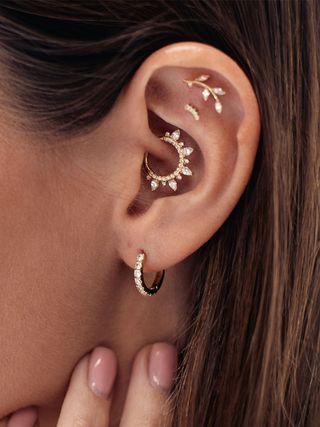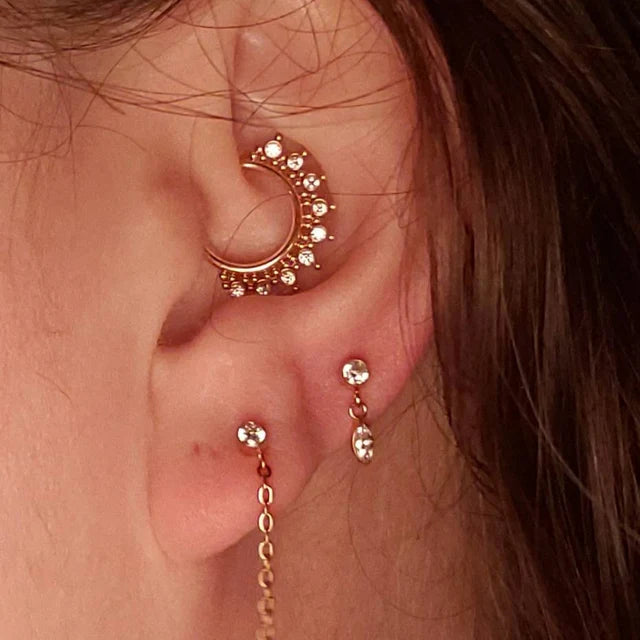Proper aftercare is crucial for ensuring a smooth healing process and avoiding complications after getting an ear piercing. Following the right practices can help you prevent infections, reduce discomfort, and ensure that your piercing heals well. Here’s a comprehensive guide to the best aftercare practices for Ear Piercing in Dubai.
1. Clean the Piercing Regularly
Use a Saline Solution
Preferred Solution:
Clean your piercing daily using a saline solution, which is a mixture of salt and water that promotes healing and prevents infection.
Application:
Apply the saline solution to the piercing using a clean cotton ball or pad. Gently dab the area, avoiding twisting or moving the jewelry.
Avoid Harsh Cleaners
Safe Products:
Refrain from using alcohol, hydrogen peroxide, or other harsh chemicals, as they can dry out and irritate the piercing.
Gentle Approach:
Stick to products specifically recommended for piercings, which are designed to be mild and effective.

2. Avoid Touching or Twisting the Jewelry
Keep Hands Clean
Hygienic Practices:
Do not touch, twist, or move the jewelry with unwashed hands. Touching the piercing can introduce bacteria, increasing the risk of infection.
Clean Hands:
If you need to touch the area, ensure your hands are thoroughly washed and sanitized.
Avoid Unnecessary Manipulation
Minimal Movement:
Try not to move or rotate the jewelry, as this can irritate the piercing and disrupt the healing process.
3. Choose Hypoallergenic Jewelry
Opt for Safe Materials
Material Choice:
Select jewelry made from hypoallergenic materials such as titanium, surgical steel, or niobium. These materials are less likely to cause allergic reactions or irritation.
Quality Jewelry:
Ensure that the jewelry is clean and free from contaminants before insertion.
Avoid Costly or Trendy Materials
Avoidance:
Refrain from using jewelry made from materials like nickel or plated metals, which can cause allergic reactions and complications.
4. Protect the Piercing from Irritants
Avoid Chemical Exposure
Protective Measures:
Keep the piercing away from hair products, makeup, and other substances that might irritate it.
Covering Up:
If swimming or participating in activities where the piercing might get exposed to dirt or chemicals, use a clean, non-stick bandage to cover the area.
Careful with Personal Care Products
Application Tips:
When applying personal care products, avoid getting them directly on or near the piercing.
5. Avoid Sleeping on the Piercing
Choose a Comfortable Position
Sleeping Tips:
Try to sleep on your back or on the opposite side of the piercing to minimize pressure and avoid irritation.
Clean Bedding:
Use clean pillowcases to avoid exposing the piercing to potential irritants.
Consider a Pillow Protector
Pillow Use:
You may also use a pillow protector to prevent any exposure to bacteria or contaminants from your pillowcase.
6. Maintain a Healthy Diet and Lifestyle
Support Healing from Within
Balanced Nutrition:
Maintain a balanced diet rich in vitamins and minerals to support your body’s natural healing processes.
Hydration:
Drink plenty of water to stay hydrated, which helps your body recover more efficiently.
7. Avoid Changing Jewelry Prematurely
Wait for Full Healing
Healing Duration:
Do not remove or change the jewelry until the piercing is fully healed, which can take 6-8 weeks or longer depending on the type of piercing.
Consult Your Piercer:
Seek advice from your piercer before changing jewelry to ensure the piercing is ready.
Use Recommended Jewelry
Safe Choices:
Stick with the jewelry provided or recommended by your piercer during the healing period.
8. Monitor for Signs of Infection
Watch for Symptoms
Infection Indicators:
Be alert for signs of infection such as redness, swelling, pus, or severe pain.
Seek Medical Advice:
If you notice any symptoms of infection or other issues, contact your piercer or a healthcare professional for evaluation and treatment.
Early Intervention
Prompt Action:
Address any concerns as soon as possible to prevent more serious complications.
9. Follow Up with Your Piercer
Schedule Appointments
Regular Check-ins:
Attend follow-up appointments with your piercer to ensure the healing process is progressing well and to address any concerns.
Professional Advice:
Your piercer can provide guidance on proper care and when it’s safe to change the jewelry.
10. Practice General Hygiene
Keep the Area Clean
Daily Routine:
Incorporate good hygiene practices into your daily routine to support the healing of your piercing.
Avoid Sharing Towels:
Use a clean towel when drying your face or hair to avoid contaminating the piercing.
Conclusion
Proper aftercare is essential for ensuring a successful healing process and maintaining the health of your new ear piercing. By following these best practices, you can reduce the risk of complications, enhance comfort, and enjoy your piercing with confidence. Remember, consistent care and attention to the guidelines provided by your piercer are key to achieving the best results.





Comments